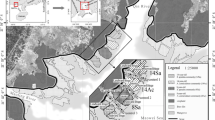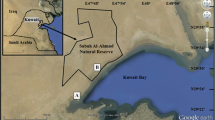Abstract
Aims
Nebkhas, discrete sand mounds formed with a plant, are a common landscape feature critical to the stability of desert ecosystems. However, adaptations which allow plants to thrive in nebkhas in extremely arid regions are still unclear. The objectives of this study were to test the role of adventitious roots (AR) in the growth and development of Nitraria sphaerocarpa-vegetated nebkhas.
Methods
We determined biomass distribution patterns and nutrient levels in small, medium, and large nebkhas representing different stages of nebkha development from young to mature, respectively.
Results
Our results showed that biomass allocation patterns and nutrient levels were very different among the different nebkha sizes. The proportions of leaves and stems increased with the increase in nebkha size, while those of AR and initial roots (IR) decreased. This indicated that, with an increase in nebkha size, N. sphaerocarpa allocated a higher proportion of biomass to leaves and stems mainly at the expense of roots, and that allowed plants to withstand increased burial depth. The proportion of AR, especially fine AR, varied among nebkha sizes. The proportion of AR in large nebkhas was significantly higher than in small nebkhas. For small and medium nebkhas, the proportion of fine AR was smaller than that of fine IR; for large nebkhas, the proportion of fine AR was higher. This indicated that AR, produced higher on the buried stems in the late stages of nebkha development, may provide increased access to water and nutrients to ensure nebkha survival. Nutrient levels were different in AR and IR of different nebkha growth stages. N and P contents of coarse AR and IR increased with nebkha size. For small nebkhas, N and K levels in fine AR were significantly lower than those in IR; however, for large nebkhas, N and K levels in AR were significantly higher than those in IR. This indicated that AR in the late stages of nebkha development may have stronger absorptive capacity for resources than IR.
Conclusions
We conclude that AR are key factor which ensured both the survival and development of N. sphaerocarpa nebkha in extremely arid environment.








Similar content being viewed by others
References
Ahmad R, Waraich EA, Ashraf MY, Ahmad S, Aziz T (2014) Does nitrogen fertilization enhance drought tolerance in sunflower? A review. J Plant Nutr 37(6):942–963
Batanouny KH (2001) Plants in the deserts of the Middle East. Springer, New York
Bellini C, Pacurar DI, Perrone I (2014) Adventitious roots and lateral roots: similarities and differences. Annu Rev Plant Biol 65(1):639–666
Brown G, Porembski S (1997) The maintenance of species diversity by miniature dunes in a sand-depleted Haloxylon salicoricum community in Kuwait. J Arid Environ 37:461–473
Cabrera-vega LL, Cruz-avero N, Hernández-Calvento L, Hernández-Cordero AI, Fernández-Cabrera E (2013) Morphological changes in dunes as an indicator of anthropogenic interferences in arid dune fields. J Coast Res SI 65(3):1271–1276
Cahill JF (2003) Lack of relationship between below-ground competition and allocation to roots in 10 grassland species. J Ecol 91(4):532–540
Cao C, Abulajiang Y, Zhang Y, Feng S, Wang T, Ren Q, Li HL (2016) Assessment of the effects of phytogenic nebkhas on soil nutrient accumulation and soil microbiological property improvement in semi-arid sandy land. Ecol Eng 91:582–589
Danin A (1996) Plants of desert dunes. Springer, Berlin
Dech J, Maun M (2006) Adventitious root production and plastic resource allocation to biomass determine burial tolerance in woody plants from Central Canadian coastal dunes. Ann Bot 98(5):1095–1105
Egilla JN, Davies FT, Drew MC (2001) Effect of potassium on drought resistance of hibiscus rosa-sinensis cv. leprechaun: plant growth, leaf macro- and micronutrient content and root longevity. Plant Soil 229(2):213–224
Eissenstat DM, Wells CE, Yanai RD, Whitbeck JL (2000) Building roots in a changing environment: implications for root 1ongevity. New Phytol 147:33–42
El-Bana MI, Nijs I, Kockelbergh F (2002) Microenvironmental and vegetational heterogeneity induced by phytogenic nebkhas in an arid coastal ecosystem. Plant Soil 247:283–293
El-Bana MI, Nijs I, Khedr AHA (2003) The importance of phytogenic mounds (nebkhas) for restoration of arid degraded rangelands in North-Ern Sinai. Restor Ecol 11:317–324
El-Bana MI, Li ZQ, Nijs I (2007) Role of host identity in effects of phytogenic mounds on plant assemblages and species richness on coastal arid dunes. J Veg Sci 18:635–644
Evans GC (1972) The quantitative analysis of plant growth. Blackwell Scientific Publications, Oxford
Field JP, Breshears DD, Whicker JJ, Zou CB (2012) Sediment capture by vegetation patches: implications for desertification and increased resource redistribution. J Geophys Res Biogeosci 117:1–9
Gilbert ME, Ripley BS (2008) Biomass reallocation and the mobilization of leaf resources support dune plant growth after sand burial. Physiol Plantarum 134(3):464–472
Gilbert ME, Ripley BS (2010) Resolving the differences in plant burial responses. Austral Ecol 35 (1):53–59
Harris D, Davy AJ (1988) Carbon and nutrient allocation in Elymus fractus seedlings after burial with sand. Ann Bot 61:147–157
Hesp P, McLachlan A (2000) Morphology, dynamics, ecology and fauna of Arctotheca populifolia and Gazania rigens nabkha dunes. J Arid Environ 44:155–172
Hesp PA, Smyth TAG (2017) Nebkha flow dynamics and shadow dune formation. Geomorphology 282:27–38
Hesp PA, Smyth TAG (2019) Anchored dunes. In: I. Livingstone and A. Warren (Eds.), Aeolian geomorphology: a new introduction: 157–178. Wiley Blackwell
Kang M, Dai C, Ji W, Jiang Y, Yuan Z, Chen HYH (2013) Biomass and its allocation in relation to temperature, precipitation, and soil nutrients in Inner Mongolia grasslands, China. PLoS One 8
Kent M, Owen NW, Dale PD (2005) Photosynthetic Responses of Plant Communities to Sand Burial on the Machair Dune Systems of the Outer Hebrides, Scotland. Ann of Bot 95(5):869–877
Khalaf FI, Al-Hurban AE, Al-Awadhi J (2014) Morphology of protected and non-protected Nitraria retusa coastal nabkha in Kuwait, Arabian gulf: a comparative study. Catena 115:115–122
King J, Nickling WG, Gillies JA (2006) Aeolian shear stress ratio measurements within mesquite-dominated landscapes of the Chihuahuan Desert, New Mexico, USA. Geomorphology 82:229–244
Liu M, Liu GH, Zheng XX (2015) Spatial pattern changes of biomass, litterfall and coverage with environment factors across temperate grassland subjected to various management practices. Landsc Ecol 30:477–486
Luo W, Zhao W, Liu B (2016) Growth stages affect species richness and vegetation patterns of nebkhas in the desert steppes of China. Catena 137:126–133
Luo W, Zhao W, Zhuang Y (2018) Sand-burial and wind erosion promote oriented-growth and patchy distribution of a clonal shrub in dune ecosystems. Catena 167:212–220
Maun M (1998) Adaptations of plants to burial in coastal sand dunes. Can J Bot 76(5):713–738
Noy-Meir I (1973) Desert ecosystems: environment and producers. Annu Rev Ecol Syst 4:25–51
Okin GS, Gillette DA, Herrick JE (2006) Multi-scale controls on and consequences of aeolian processes in landscape change in arid and semi-arid environments. J Arid Environ 65:253–275
Pernot C, Thiffault N, Desrochers A (2019) Contribution of adventitious vs initial roots to growth and physiology of black spruce seedlings. Physiol Plant 165:29–38
Pool MR, Pool SK, Parvaneh I, Dehghani Z, Rostamian M (2013) Nebkhas of Salvadora persica and their effect on the growth and survival of Prosopis cineraria, Tamarix aphylla, and Capparis decidua trees and shrubs. Flora-Morphol Distrib Funct Ecol Plants 208:502–507
Poorter H, Niklas KJ, Reich PB, Oleksyn J, Mommer L (2011) Biomass allocation to leaves, stems and roots: meta-analyses of interspecific variation and environmental control. New Phytol 193(1):30–50
Poorter H, Jagodzinski AM, Ricardo RP, Kuyah S, Luo Y, Oleksyn J, Usoltiev VA, Buckley TN, Reich PB, Sack L (2015) How does biomass distribution change with size and differ among species? An analysis for 1200 plant species from five continents. New Phytol 208(3):736–749
Pregitzer KS, Laskowski MJ, Burton AJ, Lessard VC, Zak DR (1998) Variation in sugar maple root respiration with root diameter and soil depth. Tree Physiol 18(10):665–670
Prescott CE, Maynard DG, Laiho R (2000) Humus in northern forests: friend or foe? For Ecol Manag 133:23–36
Quets JJ, Temmerman S, El-Bana MI, Al-Rowaily SL, Assaeed AM, Nijs I (2013) Unraveling landscapes with phytogenic mounds (nebkhas): an exploration of spatial pattern. Acta Oecol 49:53–63
Quets JJ, El-Bana MI, Al-Rowaily SL, Assaeed AM, Temmerman S, Nijs I (2016) A mechanism of self-organization in a desert with phytogenic mounds. Ecosphere 7(11)
Reich PB, Luo Y, Bradford JB, Poorter H, Perry CH, Oleksyn J (2014) Temperature drives global patterns in forest biomass distribution in leaves, stems, and roots. Proc Natl Acad Sci 111(38):13721–13726
Ruz MH, Arnaud H, Marin D (2017) Development of large nebkhas along an accreting macrotidal coastline, northern France. Aeolian Res 24:1–14
Samarah N, Mullen R, Cianzio S (2004) Size distribution and mineral nutrients of soybean seeds in response to drought stress. J Plant Nutr 27:815–835
Sardans J, Peñuelas J (2007) Drought changes phosphorus and potassium accumulation patterns in an evergreen Mediterranean forest. Funct Ecol 21(2):191–201
Schwinning S, Starr BI, Ehleringer JR (2005) Summer and winter drought in a cold desert ecosystem (Colorado plateau) part I: effects on soil water and plant water uptake. J Arid Environ 60(4):547–566
Shi L, Zhang ZJ, Zhang CY, Zhang JZ (2004) Effects of sand burial on survival, growth, gas exchange and biomass allocation of Ulmus pumila seedlings in the Hunshandak Sandland, China. Ann Bot 94(4):553–560
Singh DK, Sale PWG, Pallaghy CK, Mckenzie BM (2000) Phosphorus concentrations in the leaves of defoliated white clover affect abscisic acid formation and transpiration in drying soil. New Phytol 146(2):249–259
Tengberg A, Chen DL (1998) A comparative analysis of nebkhas in central Tunisia and northern Burkina Faso. Geomorphology 22(2):181–192
Tomlinson, K.W., Sterck, F.J., Bongers, F., Silva, D.A.D., Barbosa, E.R.M., Ward, D., Bakker, F.T., Kaauwen, M.van., Prins, H.H.T., Bie, S.de., Langevelde, F.van. 2012. Biomass partitioning and root morphology of savanna trees across a water gradient. J Ecol, 100(5): 1113–1121
Touchette BW, Moody JWG, Byrne CM, Marcus SE (2012) Water integration in the clonal emergent hydrophyte Justicia americana: benefits of acropetal water transfer from mother to daughter ramets. Hydrobiologia 702:83–94
Wang X, Wang T, Dong Z, Liu X, Qian G (2006) Nebkha development and its significance to wind erosion and land degradation in semi-arid northern China. J Arid Environ 65:129–141
Zhang P, Yang J, Zhao L, Bao S, Song B (2011) Effect of Caragana tibetica nebkhas on sand entrapment and fertile islands in steppe-desert ecotones on the Inner Mongolia plateau, China. Plant Soil 347(1–2):79–90
Zhang G, Yang Q, Wang X, Zhao W (2015) Size-related change in Nitraria sphaerocarpa patches shifts the shrub-annual interaction in an arid desert, northwestern China. Acta Oecol 69:121–128
Zhang G, Zhao W, Zhou H, Yang Q, Wang X (2017) Extreme drought stress shifts net facilitation to neutral interactions between shrubs and sub-canopy plants in an arid desert. Oikos 127(3):381–391
Zhao WZ, Liu B (2010) The response of sap flow in shrubs to rainfall pulses in the desert region of China. Agric For Meteorol 150:1297–1306
Zhou H, Zhao WZ, Luo WC, Liu B (2015) Species diversity and vegetation distribution in nebkhas of nitraria tangutorum, in the desert steppes of China. Ecol Res 30(4):1–10
Zhuang YL, Zhao WZ (2014) Dew variability in three habitats of a sand dune transect in a desert oasis ecotone, northwestern China. Hydrol Process 28:1399–1408
Acknowledgments
We would like to thank Dr. Kathryn B. Piatek (kbpiatek@gmail.com) for her assistance with English language editing and valuable comments on this article. We gratefully acknowledge the journal’s editors and anonymous reviewers for their valuable comments on our manuscript. This study was supported by the National Natural Science Foundation of China subsidization project (Grant No. 41701600).
Author information
Authors and Affiliations
Corresponding author
Additional information
Responsible Editor: Amandine Erktan.
Publisher’s note
Springer Nature remains neutral with regard to jurisdictional claims in published maps and institutional affiliations.
Electronic supplementary material
ESM 1
(XLSX 16 kb)
Rights and permissions
About this article
Cite this article
Luo, W., Zhao, W. Adventitious roots are key to the development of nebkhas in extremely arid regions. Plant Soil 442, 471–482 (2019). https://doi.org/10.1007/s11104-019-04209-4
Received:
Accepted:
Published:
Issue Date:
DOI: https://doi.org/10.1007/s11104-019-04209-4




